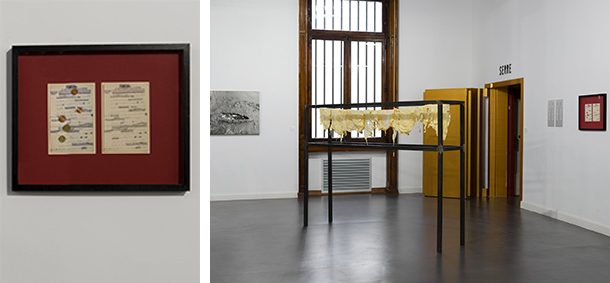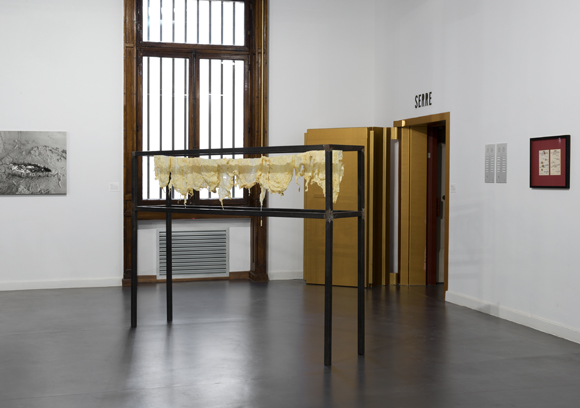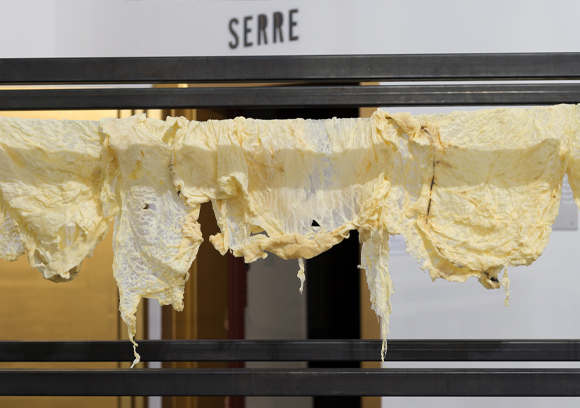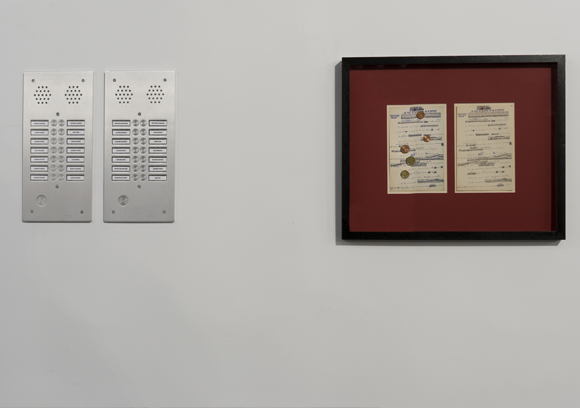| |
|
|
58.
| Georges Bataille, The Rest |
| |


2016, Le Reste, sculpture en graisse animale et brouillon autographe de La Part maudite.
Exhibition view of Defenses, la traversée des inquietudes, La Banque, 2016, Bethune.
Courtesy of the artist and Analix Forever, Geneva.
Ed. of 5 + 1 A.P.
He explores the question of the market value of this vestige and its ironic ability to be exchanged for money; an incarnation of Marx’s study of commodity fetishism.
Moreover, this simple piece of paper, becoming a readymade, is then moved into the art market world where its value will be increased if it finds an acquirer.
Léa Bismuth, June 20th 2016

Georges Bataille, The Rest
Exhibition view of Defenses, la traversée des inquietudes, La Banque, 2016, Bethune.
Courtesy of the artist.

Georges Bataille, The Rest
Exhibition view of Defenses, la traversée des inquietudes, La Banque, 2016, Bethune.
Courtesy of the artist.

Georges Bataille, The Rest
Exhibition view of Defenses, la traversée des inquietudes, La Banque, 2016, Bethune.
Courtesy of the artist.
|
|
|
|
|
|
En avril 2016, mounir fatmi s’est rendu propriétaire d’un brouillon autographe de La Part maudite, feuille jaunie possédant de nombreuses ratures extrêmement soignées, hachures dessinées et annotations de la main de Georges Bataille*. Il s’interroge sur la question de la valeur marchande accordée à cette trace ironiquement monnayable, incarnation du fétichisme de la marchandise étudiée par Marx. De plus, ce simple bout de papier, devenant ready-made, est alors déplacé dans le monde du marché de l’art, et sera l’objet d’une élévation de sa valeur si la pièce trouve un acquéreur. Le procédé est connu depuis Duchamp, mais là où l’artiste étonne, c’est dans la manière avec laquelle il joue sur les codes de l’appropriationnisme afin d’ouvrir le dialogue avec une autre oeuvre, sculpturale, faisant strictement écho aux fêtes sacrificielles.
Loin du simple prélèvement conceptuel, nous sommes face à une pièce on ne peut plus organique : face aux restes du mouton de la fête musulmane de l’Aīd al-Kabīr, commémorant le sacrifice d’Abraham. En effet, sur un fil, ne restent que les lambeaux de graisse séchés, reprenant la forme de l’animal une fois sa viande consommée, et qui ne sont pas sans rappeler les échines bovines ornant les parois des grottes de Lascaux.
Cette installation fait écho à une photographie réalisée en 1999 pour laquelle l’artiste, muni de pinces à linge, avait fait sécher la graisse sur le toit de sa maison familiale à Tanger. « La graisse doit être considérée selon un double usage, explique-t-il : elle est à la fois la force vive, le symbole de l’énergie dépensée ; mais c’est aussi un combustible, l’énergie elle-même, car c’est bien la graisse qui alimente le feu ».
Léa Bismuth, 20 juin 2016
* Ce brouillon manuscrit date de 1948 et constitue une étape essentielle dans l’écriture de l’ouvrage, qui ne paraitra qu’un an plus tard. On peut y lire le texte suivant : « Le rôle de l’Eglise et de la Réforme. L’économie chrétienne avant la Réforme. (...) Le Christianisme assume la malédiction latente de la richesse. Le Seigneur a renversé les puissants de leu trône, il élève les petits. La festivité païenne succombe sous les coups de cette haine ; juridiquement, la fortune elle-même ne fut pas atteinte, elle fut au contraire libérée de son obligation religieuse (...) Aux obligations «pour autrui» des jeux et des fêtes, le christianisme a fait succéder l’aumône - que chaque personne peut donner ». Précisons qu’au verso de la feuille : est écrit au crayon par Bataille, « La part maudite ».
|
|
In April of 2016, mounir fatmi became the owner of an autographed draft of The Accursed Share. A yellowed text possessing a number of extremely carefully crossed-out lines, hatched drawings, and annotations by Georges Bataille*. He explores the question of the market value of this vestige and its ironic ability to be exchanged for money; an incarnation of Marx’s study of commodity fetishism. Moreover, this simple piece of paper, becoming a readymade, is then moved into the art market world where its value will be increased if it finds an acquirer. This process has been in existence since Duchamp but the artist surprises with the way in which he plays with the codes of appropriation so that he may open dialogue with another sculptural piece, while strictly evoking sacrificial celebrations.
Far from a simple conceptual sample, we are faced with a piece that could not be more organic: the remaining parts of the sheep from the Muslim festival, the Aīd al-Kabīr, commemorating Abraham’s sacrifice. Only the dried fat slabs remain hanging on a wire, resuming the shape of the animal once all of the meat has been consumed, and it calls to mind the bovine spines adorning the walls of the Lascaux caves.
This installation recalls a photograph taken in 1999 for which the artist, equipped with clothespins, had dried the fat on the roof of his family home in Tangier. “The fat must be considered as having a dual purpose,” he explains. “It is the living force, the symbol of energy spent, but it is also a fuel, the energy itself, for it is the fat that feeds the fire.”
Léa Bismuth, June 20 2016
Traduit du français par Christina Washington.
*This manuscript draft dates from 1948 and is an essential step for the writing of the book, which was not completed until one year later. It reads: “The Role of the Church and the Reformation. The Christian economy before the Reform. (…) Christianity assumes the latent curse of wealth. The Lord has overthrown the mighty from their thrones, and he raises up the meek. The pagan festival fell under the blows of this hatred; Legally, fortune itself was not contravened; on the contrary it was liberated from its religious constraints. (…) As for the “other” obligations of games and festivals, Christianity ushered in alms - whatever each person can give.” On the back of the sheet, “The Accursed Share” is written in pencil by Bataille.
|
|
|
|